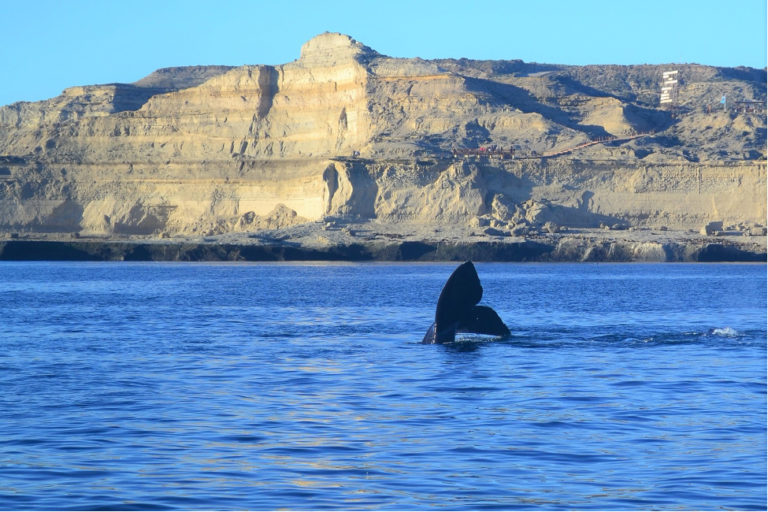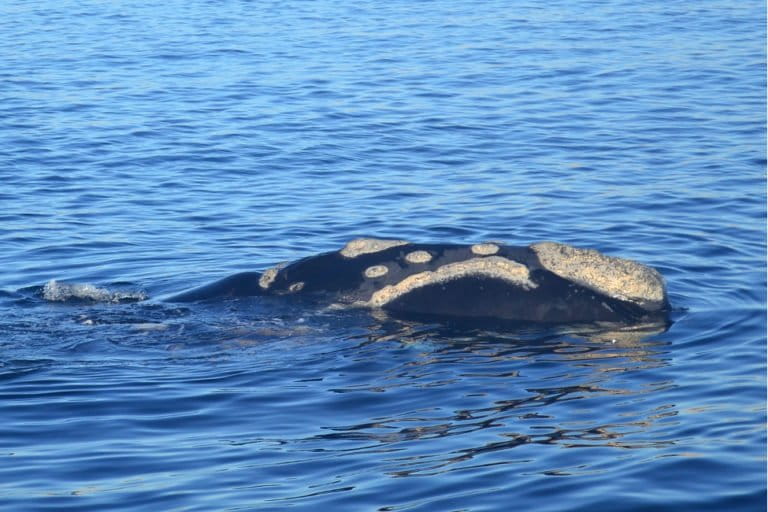- Southern right whale populations near Argentina have suffered surprising losses during recent El Niño years.
- Intense warmings in 1997-98 and 2015-16 each killed 4 to 5 percent of right whales in the southwest Atlantic Ocean, researchers estimate.
- If El Niño events worsen, models suggest the encouraging recovery of southern right whales could stall or even reverse.
Southern right whales, one of the most historically hunted whales globally, have recovered nicely since the whaling era. But a new analysis has shown that El Niño events, which warm the seas near South America, made right whale populations dive to a shocking degree in those years, researchers reported recently in Science Advances.
Scientists examined an archive of photo identifications of more than 4,000 southern right whales (Eubalaena australis) to track 1,380 individuals off of Peninsula Valdés, Argentina—the largest calving ground in the Southwest Atlantic Ocean. The identifications revealed that intense El Niño events in 1997-98 and 2015-16 may have killed about 4 percent and 5 percent of the adult females near Argentina in those years, respectively. In most other years, mortality in this population averages just 1 percent.

With a warming climate, severe El Niño seasons may become more frequent. If so, scientists project that the whales will not come close to the predicted carrying capacity of 35,000 whales based on their historic pre-whaling numbers by the end of the century. Previous studies had forecast that promising recovery trend based on an average annual growth rate of about 6 percent for the entire population of right whales in the Southern Hemisphere.
“Saying that the population is growing 6 percent every year doesn’t guarantee increases in the next year, because threats are impacting their population,” lead author Macarena Agrelo, a Ph.D. candidate in ecology at the Federal University of Santa Catarina in Brazil, told Mongabay.
When humans hunted whales decades ago, the right whale was the “right” whale to hunt because its high fat content, which yields large quantities of oil, made each whale float after dying, whereas other species sank. Whalers decimated right whales in both the North and South Atlantic.

The critically endangered North Atlantic right whale (Eubalaena glacialis) has declined to 336 individuals, scientists estimate. A recent study from Cornell University concluded that warmer waters also affect this fragile population by shifting feeding grounds and decreasing food availability. Their Southern Atlantic cousins, once down to just a few hundred whales, have rebounded to roughly 5,500 individuals in 2020.
Agrelo and her colleagues used aerial survey photos from the last 50 years to identify repeated individual sightings of mostly female southern right whales. The animals carry distinctive pattern of white markings on the tops of their heads, caused by clusters of whale lice, distinguishing them like bar codes spanning several meters.

In normal, non-El Niño years, about 1 percent of the southern right whale population is lost to entanglement in fishing nets, strikes by ships, and stress by gulls that attack whales to feed on their skin. In addition to the extreme losses in 1997-98 and 2015-16, Agrelo and her colleagues noted slight upticks in deaths in less intense El Niño years.
Southern right whales are essential to the Southern Ocean ecosystem due to rich supplies of iron in their poop. These excretions fuel the growth of phytoplankton and other organisms at the base of the marine food web. Massive swarms of Antarctic krill (Euphausea superba), a tiny crustacean, eat these phytoplankton and then feed the rest of the ecosystem—from commercial fish species and birds to sharks and baleen whales.
“[Right whales] play a really important role in marine ecosystems,” said Kelly Keen, a Ph.D. student at the University of California, Santa Cruz, who studies the ecology of humpback whales. “They do a lot of ocean mixing, vertically and horizontally. They deliver and recycle these nutrients, essentially by fertilizing the ocean waters with their feces.”

Agrelo’s team suspects the El Niño warmings reduced the numbers of krill in the South Atlantic. As a result, more female right whales died when they could not eat enough krill to rebuild their blubber layers after giving birth and nursing—which usually saps one-third of their body weight. They must gain back thousands of pounds to breed again, but that depends on eating tons of krill, which are at risk from stronger and more frequent El Niño seasons.
Models like these will help researchers understand how different marine ecosystems might change as climate patterns become more extreme, Keen said. “Certain populations may respond to climate change,” she told Mongabay. “But not all populations are going to respond equally.”
Editor’s note: This piece was edited shortly after publication to clarify the process used to identify individual whales.
Citation:
- Agrelo, M., Daura-Jorge, F. G., Rowntree, V. J., Sironi, M., Hammond, P. S., Ingram, S. N., … & Simões-Lopes, P. C. (2021). Ocean warming threatens southern right whale population recovery. Science Advances, 7(42), eabh2823-eabh2823. DOI: 10.1126/sciadv.abh2823
Brian Phan (@PhantasticTides) is a graduate student in the Science Communication program at the University of California, Santa Cruz. Other Mongabay stories produced by UCSC students can be found here.
